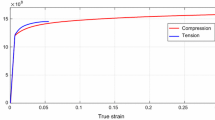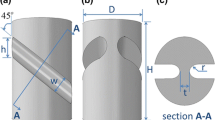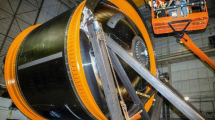Abstract
This paper presents an experimental and numerical study of the potential of the Shear Compression Disk specimen (SCD) to characterize the plastic flow and fracture of metals under various levels of stress triaxiality at strain rates of up to 104 1/s. The main loading mode in that specimen is shear with triaxiality ranging from 0 to -0.8. The specimen is relatively small and fits into a standard split Hopkinson pressure bar system. Aluminum 7075-T651 alloy was chosen for a test case study. Experimental and numerical investigations reveal the adequacy of the SCD specimen for the study of mechanical properties of materials under high strain-rates and low, though wide, range of stress triaxialities.












Similar content being viewed by others
References
Bridgman PW (1952) Studies in Large Plastic Flow. McGraw-Hill
Rice JR, Tracey DM (1969) On the ductile enlargement of voids in triaxial stress fields. J Mech Phys Solids 17:201–217
Ramesh KT (2002) Effects of high rates of loading on the deformation behavior and failure mechanisms of hexagonal close-packed metals and alloys. Metall Mater Trans A 33A:927–935
Edwards M (2006) Properties of metals at high rates of strain. Mater Sci Tech 22:453–462
Meyers MA, Xu YB, Xue Q, Pérez-Prado MT, McNelley TR (2003) Microstructural evolution in adiabatic shear localization in stainless steel. Acta Mater 51:1307–1325
Kad BK, Gebert JM, Perez-Prado MT, Kassner ME, Meyers MA (2006) Ultrafine-grain-sized zirconium by dynamic deformation. Acta Mater 54:4111–4127
Rittel D, Ravichandran G, Lee S (2002) A shear compression specimen for large strain testing. Exp Mec 42:58–64
Ames M, Markmann J, Birringer R (2010) Mechanical testing via dominant shear deformation of small-sized specimen. Mat Sci Eng A-Struct 528:526–532
Masson I, Guegan P, Lesaffre AS, Quirion Y, Poitou A (2006) Dynamic compressive testing under confining pressure on a quasi-brittle material. J Phys Iv 134:707–712
Rittel D, Hanina E, Ravichandran G (2008) A note on the direct determination of the confining pressure of cylindrical specimens. Exp Mech 48:375–377
Mae H, Teng X, Bai Y, Wierzbicki T (2008) Comparison of ductile fracture properties of aluminum castings: Sand mold vs. metal mold. Int J Solids Struct 45:1430–1444
Mae H (2009) Characterization of material ductility of PP/EPR/talc blend under wide range of stress triaxiality at intermediate and high strain rates. Journal of Applied Polymer Science 111:854–868
Alves M, Jones N (1999) Influence of hydrostatic stress on failure of axisymmetric notched specimens. J Mech Phys Solids 47:643–667
Barton DC (2004) Determination of the high strain rate fracture properties of ductile materials using a combined experimental/numerical approach. Int J Impact Eng 30:1147–1159
Børvik T, Hopperstad OS, Dey S, Pizzinato EV, Langseth M, Albertini C (2005) Strength and ductility of Weldox 460 E steel at high strain rates elevated temperatures and various stress triaxialities. Eng Fract Mech 72:1071–1087
Børvik T, Hopperstad OS, Pedersen KO (2010) Quasi-brittle fracture during structural impact of AA7075-T651 aluminium plates. Int J Impact Eng 37:537–551
Wierzbicki T, Bao Y, Lee Y-W, Bai Y (2005) Calibration and evaluation of seven fracture models. Int J Mech Sci 47:719–743
Dorogoy A, Karp B, Rittel D (2011) A shear compression disk specimen with controlled stress triaxiality under quasi-static loading. Exp Mech 51:1545–1557
Abaqus/CAE version 6.9-EF1 2009. Dassault Systemes Simulia Corporation, Providence, RI, USA
Klepaczko JR (1994) An experimental technique for shear testing at high and very high strain rates. the case of a mild steel. Int J Impact Eng 15:25–39
Roessig KM, Mason JJ (1999) Adiabatic shear localization in the dynamic punch test, part I: experimental investigation. Int J Plasticity 15:241–262
Rusinek A, Klepaczko JR (2001) Shear testing of a sheet steel at wide range of strain rates and a constitutive relation with strain-rate and temperature dependence of the flow stress. Int J Plasticity 17:87–115
Li QM, Jones N (2002) Response and failure of a double-shear beam subjected to mass impact. Int J Solids Struct 39:1919–1947
Li Z, Bi X, Lambros J, Geubelle PH (2002) Dynamic fiber debonding and frictional push-out in model composite systems: experimental observations. Exp Mech 42:417–425
Dabboussi W, Nemes JA (2005) Modeling of ductile fracture using the dynamic punch test. Int J Mech Sci 47:1282–1299
Abaqus/CAE version 6.9-EF1 (2009) Abaqus documentation. Abaqus Analysis User’s Manual, chapters 20–21, Dassault systemes. Springer, New York
Pedersen KO, Borvik T, Hopperstad OS (2011) Fracture mechanisms of aluminium alloy AA7075-T651 under various loading conditions. Materials and Design 32:97–107
Rauch GC, Leslie WC (1972) The extent and nature of the strength-differential effect in steels. Metall Trans 3:373–385
Mahnken R (2001) Strength difference in compression and tension and pressure dependence of yielding in elasto-plasticity. Comput Method Appl M 190:5057–5080
Gao X, Zhang T, Hayden M, Roe C (2009) Effects of the stress state on plasticity and ductile failure of an aluminum 5083 alloy. International Journal of Plasticity 25:2366–2382
Nicholas T (1981) Tensile testing of materials at high rates of strain. Experimental Mechanics 21:177–185
Celentano DJ, Cabezas EE, Garcia CM, Monsalve AE (2004) Characterization of mechanical behaviour of materials in the tensile test: experiments and simulation. Modelling Simul Mater Sci Eng 12:S425–S444
Brar NS, Joshi VS, Harris BW (2009) Constitutive model constants for Al7075-T651 and Al7075-T6. Shock Compression of Condensed Matter – 2009, Eds. Elert ML, Buttler WT, Anderson WW, Proud WG. American Institute of Physics
Johnson GR, Cook WH (1985) Fracture characteristics of three metals subjected to various strains, strain rates, temperatures and pressures. Engineering Fracture Mechanics 21:31–48
Acknowledgement
Financial support from Vatat (2013152) is greatly acknowledged. The authors wish to thank A. Amon and A. Reuven (Materials Mechanics Center) for their dedicated technical assistance.
Author information
Authors and Affiliations
Corresponding author
Appendix A: A Method for Constitutive Relation Extraction
Appendix A: A Method for Constitutive Relation Extraction
As an additional confirmation of the obtained stress–strain curve for the high strain-rate loading, the experimental results were interpreted directly using a similar procedure to the one which is applied for SCS specimens impacted in a SHPB apparatus. The procedure requires a transformation of the axial force and displacements on the SCD faces to the averaged von Mises stress and averaged total strain of the working line of the gauge (Fig. 3(a)). The procedure and its results are detailed here.
For that transformation the following derivation and relations have been used. We first verify numerically that, during impact the averaged Mises stress and the averaged total equivalent strain along the midline of the gauge (Fig. 3(a)), represent the \( \sigma - \varepsilon \) curve which was inputted into the numerical simulation as the material property. This is similar to what has been shown for the shear compression specimen (SCS) [8] at strain rate of 3,000 1/s. Hence a similar data reduction technique can be used here for the shear compression disk (SCD). The averaged total equivalent strain  on the mid-line of the gauge is related to the applied displacements (d) on the upper face of the specimen during the impact in the SHPB according to the approximate relation
on the mid-line of the gauge is related to the applied displacements (d) on the upper face of the specimen during the impact in the SHPB according to the approximate relation
where w is the width of the slot. The averaged von Mises stress  on the mid-line of the gauge is related to the applied force (P) by:
on the mid-line of the gauge is related to the applied force (P) by:
The applied force P(t) is related to the measured transmitted strain \( \varepsilon (t) \) by: \( P(t) = {\varepsilon_t}(t)\,E\,A \) where E and A are elastic modulus and cross sectional area of the transmitting bar respectively. The sheared area of the gauge can be estimated by \( {A^s} \cong Lh \) where L is the circumferential line:\( L = \pi \left( {D + w} \right) \) where D is the inner diameter of the specimen’s slots (equal to the incident bar diameter) and h is the vertical height of the specimen gauge. An average shear stress in the gauge is \( P(t)/{A^s} \). Equation (A2) simply approximates the normalized von Mises stress on the mid-line of the gauge  to the normalized averaged applied shear \( \frac{{P(t)}}{{{\sigma_y}{A^s}}} \) where the static yield stress of the specimen is \( {\sigma_y} \). The coefficients \( {c_i}\,,\,\,i = 1...6 \) are calculated from the numerical analysis. Using for example the known static properties of Aluminum 7075-T651 and simulating the impact of a specimen with β = 15° (specimen 17 - Table 1) the coefficients are: c1 = 0.14442, c2 = 0.81074, c3 = -0.40775, c4 = 3.6816, c5 = -4.4228 and c6 = 2.4896. Using (Equations (A1) and (A2)) with these coefficients and the experimentally measured (d(t), P(t)) yield the first approximation for the dynamic \( \sigma - \varepsilon \) curve. The resulting stress–strain curve is shown here in Fig. 13 along with the quasi-static curve and the dynamic curve obtained by the iterative process employing full numerical simulation (Fig. 7). An agreement in the results obtained by the two analyses is noted.
to the normalized averaged applied shear \( \frac{{P(t)}}{{{\sigma_y}{A^s}}} \) where the static yield stress of the specimen is \( {\sigma_y} \). The coefficients \( {c_i}\,,\,\,i = 1...6 \) are calculated from the numerical analysis. Using for example the known static properties of Aluminum 7075-T651 and simulating the impact of a specimen with β = 15° (specimen 17 - Table 1) the coefficients are: c1 = 0.14442, c2 = 0.81074, c3 = -0.40775, c4 = 3.6816, c5 = -4.4228 and c6 = 2.4896. Using (Equations (A1) and (A2)) with these coefficients and the experimentally measured (d(t), P(t)) yield the first approximation for the dynamic \( \sigma - \varepsilon \) curve. The resulting stress–strain curve is shown here in Fig. 13 along with the quasi-static curve and the dynamic curve obtained by the iterative process employing full numerical simulation (Fig. 7). An agreement in the results obtained by the two analyses is noted.
Comparison of the quasi-static (blue) and dynamic (green, red) \( \sigma - \varepsilon \) curves for Aluminum 7075-T651 obtained by specimen 17. The resulting dynamic experimental \( \sigma - \varepsilon \) curve (green) is obtained by application of (equations (A1) and (A2)) with the experimental results (d(t),P(t)). The resultant dynamic \( \sigma - \varepsilon \) curve (red) is numerical modification of the green line
Rights and permissions
About this article
Cite this article
Karp, B., Dorogoy, A. & Rittel, D. A Shear Compression Disk Specimen with Controlled Stress Triaxiality Under Dynamic Loading. Exp Mech 53, 243–253 (2013). https://doi.org/10.1007/s11340-012-9630-4
Received:
Accepted:
Published:
Issue Date:
DOI: https://doi.org/10.1007/s11340-012-9630-4





